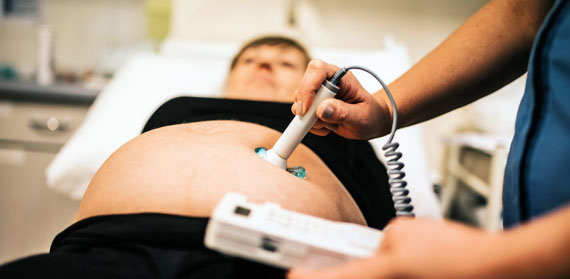Guest post by Dr. Elizabeth Bailey, Centre for Innovative Research Across the Life Course
For an anxious expectant mother needing emergency procedures during birth, the military-style orders being given by one medic to another and the myriad of unknown midwives and doctors around her bedside can be overwhelming – and potentially traumatic.
The health professionals are all focused on safely assisting the birth and maintaining the woman’s health – but often the simple things such as explaining who is in the room or maintaining eye contact with the soon-to-be new mum are forgotten.
It is thought that this lack of personal contact during emergency births has the potential to lead to psychological dissociation with birth events and we know the incidence of diagnosed post traumatic stress disorder after birth is increasing.
This is why capturing the patient’s perspective is one of the most important aspects of new maternity safety training films that are being created by University Hospitals Coventry and Warwickshire (UHCW) and Coventry University.
The need for an increased focus on maternity safety training was identified as a result of The Kirkup inquiry in 2015, which focused on a catalogue of serious failings at University Hospitals of Morecambe Bay NHS Foundation in a damning report into the deaths of 11 babies and one mother at the Cumbrian hospital trust. It prompted a range of safety improvements and policy changes that have affected every midwife, obstetrician and maternity worker in the UK.
Following the report, every hospital trust in the country had to bid for money from the Maternity Safety Training Fund to increase multidisciplinary safety training in maternity services. In addition to this, there was the opportunity to submit ideas to a Safety Training Innovation Fund and an idea was developed by the maternity risk team at UHCW NHS Trust. A total of 25 trusts were awarded a share of £250,000.
The funding UHCW received from its successful bid has gone towards putting together training films, which I have been involved in creating and evaluating as part of my research work for the Centre for Innovative Research Across the Life Course at Coventry University. The films have maternity safety alongside women’s experience at the heart of them.
We wanted to create something very visual and engaging that would really highlight the issues to staff and prompt discussion and debate in the training room. We will be using a head cam in training simulations or ‘skills drills’ to show exactly what a woman sees and hears during an emergency situation; whether that’s staff offering reassuring words to her or relaying information to each other in complex medical jargon.
This woman’s view will be recorded during maternity staff’s training who will then get the chance to watch the film back, giving them a completely different angle on the work they were doing. We hope it will make them think more about how they communicate with women, partners – and each other and may inform how we conduct the drills.
Our other film – which was shot a few weeks ago by Fresh@CU – looks at a typical day in the life of a labour ward, but with some deliberate mistakes thrown in to keep staff constantly on the lookout for better ways of maintaining safety..
We don’t want this training to be overly critical or negative but rather have staff engage with it and enjoy it.
Most importantly we hope the lessons they take away from it will become engrained in their day to day work and thinking.
We’re hoping to show the film for the first time in training sessions in the next few months, and we’re looking forward to hearing feedback from staff.
We were very encouraged when our project was mentioned by Health Minister Philip Dunne in the House of Commons during the annual Baby Loss and Maternity Safety awareness debate in October to highlight the impact of the innovation funds.
The recognition that our innovative training received in Parliament was fantastic – and shows that we are leading the way in developing this type of training. We aim to evaluate the films to determine if they are making a difference to staff training – which in turn we hope, will lead to safer outcomes for women and babies.




Comments are disabled